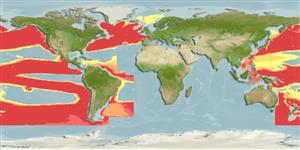>
Lophiiformes (Anglerfishes) >
Oneirodidae (Dreamers)
Etymology: Phyllorhinichthys: Greek, 'phyllon' = leaf + Greek, 'rhinos' = nose or snout + Greek, 'ichthys' = fish (in reference to the leaf-like flaps on its snout) (Ref. 86949).
Environment: milieu / climate zone / depth range / distribution range
Ecología
marino batipelágico; rango de profundidad 1000 - 3600 m (Ref. 53300). Deep-water
Eastern Pacific: 2 records of which holotype, Off Guadalupe Island, Mexico (29°16'30"-29°35'30"N, 118°11'30"-118°18'30"W). North-eastern Atlantic: 1 record (56°N, 26°W). Central-western Atlantic: 1 record in Sargasso Sea. Indian Ocean: 1 record.
Tamaño / Peso / Age
Maturity: Lm ? range ? - ? cm
Max length : 12.0 cm SL (female)
Short description
Claves de identificación | Morfología | Morfometría
Radios blandos dorsales (total) : 5 - 6; Radios blandos anales: 5. Diagnosis: Metamorphosed females of this species have short illicium (11.5-12.6%SL); have two anterior escal appendage; and considerably shorter, stouter, distal escal appendage (6.4-15.8%SL) (Ref. 53300). Further characterized by presence of vomerine teeth; strongly convex dorsal margin of frontal bones; well developed sphenotic spines; skin is smooth and naked, without dermal spinules; darkly pigmented skin of caudal peduncle extends well past base of caudal fin (Ref. 86949).
Known from nine (9) known specimens (Ref. 10523, 53300). A 9.6-cm specimen appears to be a sexually mature, where the right ovary, about 26 mm long (27.1%SL), contains approximately 130,000 eggs (count based on extrapolation from wet weight) each about 0.3 mm in diameter (Ref. 53300).
Life cycle and mating behavior
Madurez | Reproducción | Puesta | Huevos | Fecundidad | Larva
Bertelsen, E., 1986. Oneirodidae. p. 1383-1399. In P.J.P. Whitehead, M.-L. Bauchot, J.-C. Hureau, J. Nielsen, and E. Tortonese (eds.) Fishes of the North-eastern Atlantic and the Mediterranean. UNESCO, Paris, Vol. 3. (Ref. 10523)
IUCN Red List Status (Ref. 130435: Version 2024-2)
Threat to humans
Harmless
Human uses
Herramientas
Special reports
Download XML
Fuentes de Internet
Estimates based on models
Preferred temperature (Ref.
123201): 2.1 - 3.5, mean 2.6 °C (based on 1387 cells).
Phylogenetic diversity index (Ref.
82804): PD
50 = 0.7500 [Uniqueness, from 0.5 = low to 2.0 = high].
Bayesian length-weight: a=0.01995 (0.00906 - 0.04395), b=3.01 (2.83 - 3.19), in cm total length, based on all LWR estimates for this body shape (Ref.
93245).
Nivel trófico (Ref.
69278): 3.8 ±0.5 se; based on size and trophs of closest relatives
Resiliencia (Ref.
120179): Medio, población duplicada en un tiempo mínimo de 1.4-4.4 años (Preliminary K or Fecundity.).
Fishing Vulnerability (Ref.
59153): Low vulnerability (10 of 100).
